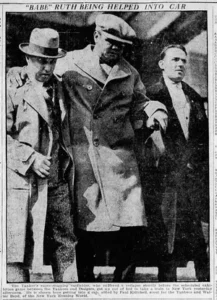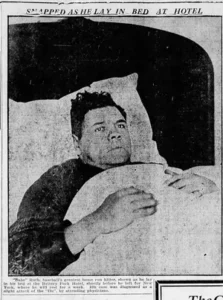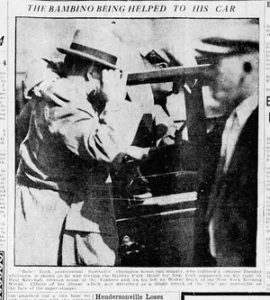
Rumors of Babe Ruth’s death after Asheville stop were greatly exaggerated
By Anne Chesky
“Babe Ruth, American baseball champion and national hero of every schoolboy, is reported to have died in a train whilst en route to New York,” read a headline in the morning edition of the Irish newspaper The Belfast Telegraph on Thursday, April 9, 1925. Ruth had collapsed two days earlier as he disembarked from a train at the Asheville railway depot. After a night convalescing in the city, a weakened Ruth was loaded on a train to New York. Rumors of his death began circulating as the train passed through southwest Virginia.
These rumors devastated the American public. In the early 1920s, Babe Ruth dominated the sports sections of American newspapers, becoming baseball’s first true celebrity.
George Herman Ruth may have been born in 1895 in Baltimore, but the baseball star became “Babe” in 1914 in North Carolina. While playing in Fayetteville shortly after signing his first professional baseball contract with the minor league Baltimore Orioles, his teammates learned that Orioles manager Jack Dunn had legally adopted the talented teenager to circumvent a custody order (which lasted until Ruth turned 21) at the orphanage and reform school where Ruth was raised. Ruth was soon christened “Dunn’s baby,” which was later shortened to “Babe.” In the last inning of the team’s last game in Fayetteville, Babe Ruth hit his first professional home run.
By the time he arrived in Asheville in 1925, he had broken the previous season-long home run record. (He hit 54 home runs in 1920, breaking his 1919 record of 29. In 1921, he broke it again with 59 homers.) He had already been named league MVP and won four World Series titles – three with the Boston Red Sox and one with the New York Yankees. So when he arrived in Asheville to play an off-season exhibition game with the Yankees against the Brooklyn Dodgers at Asheville’s brand-new McCormick Field, baseball fans were eagerly anticipating watching the home run king smash balls over the outfield fence. The game was expected to attract “one of the largest crowds ever assembled on McCormick Field.”
But, to the dismay of Asheville baseball fans, as the special train carrying the team from Knoxville prepared to pull into Asheville’s railway station, Ruth complained to his teammates that he felt “indisposed.” He stepped onto the platform, collapsed into the arms of his teammates Joe Dugan and Steve O’Neill, and, unconscious, was placed in a taxi and rushed to the Battery Park Hotel in downtown Asheville to be attended to by a doctor.

While his teammates took the field for the exhibition game, Ruth stayed in his room. Ruth’s absence was explained as a mild bout of “flu and a stomach disorder” exacerbated by the winding train trip into the mountains of North Carolina.
Local reporter Dick Wasson wrote, “Ruth does not observe a strict diet … and this more than anything else, was given as a probable cause for his illness.” The Yankee’s manager assured the public, “Ruth’s recent ailment was due to acute indigestion. His present condition is not serious.”
Still, it was determined that Ruth needed treatment by his New York doctors, so the on the afternoon of April 8, after being dressed by Paul Kritchell, a Yankees scout, and Robert Boyd, a newspaper reporter, Ruth walked out the front door of the Battery Park supported by the two men, who placed him in a waiting taxi.
Wasson wrote of the scene: “Ruth as he left the hotel showed the signs of being very sick. The lines in his face were drawn, while his strength, powerful as it is when he is in condition, failed him almost to a helpless point. Throwing practically his entire weight of 230 pounds upon Kritchell and Boyd, he shuffled to the cab. Here it was necessary for the men to aid him in entering. After seating himself, Ruth put his hand to his face. … He said nothing.”
After he boarded the train in Asheville, the rumors began and subsequently “spread like wildfire.” Anxious New Yorkers, hearing or reading that the great slugger was dead, began calling the local news offices hoping for more information. The anxiety persisted for most of the day until the evening edition of the newspapers hit the stands with front page headlines assuring people that the rumor that Babe Ruth had died was unfounded and that “Ruth was in better physical condition than he was when he left the North Carolina town where he was stricken.”
Though he apparently weathered the train ride reasonably well and was feeling well enough to go to the washroom to brush his hair and wash up in preparation for greeting his friends and fans at Penn Station (one source claimed that 25,000 people had come to check on the Babe’s status), he collapsed again and hit his head on the washroom sink. An unconscious Ruth, now with a potential concussion, was transported to St. Vincent’s Hospital. Though fans and the Yankees franchise hoped The Great Bambino would be cleared to play in the season opener the following week, after surgeries to remove “an intestinal abscess” and an ulcer, he did not make it back into action until June 1.

Weeks later, an article, “The King’s Pajamas,” by baseball columnist Bill Corum, appeared in the newly-founded New Yorker magazine elaborating slightly on Ruth’s time in Asheville. Apparently, upon his arrival at the hotel, Ruth had no pajamas and – in true superstar fashion – insisted that he would only wear pink pajamas.
The article read, in part, “The fourth breakfast porterhouse and a rough train ride had upset His Majesty. … The King had no pajamas. … Search in every store in Asheville disclosed only one pair of pink pajamas in the city. They were size 42. The King measured a goodly 48. … By discarding the trousers altogether and splitting the coat up the back, they were made to do. … (The pajamas) positively set the exclusive social circles of Asheville and Biltmore, N.C., agog.”
To this day, no one really knows the exact list of ailments — or their causes — that Ruth suffered from during the spring of 1925, partly because no one except Ruth’s family and his doctor were allowed in his hospital room. Reporters were accustomed to having full access to the ballplayer, and without access, reports on Ruth’s condition were merely rumors. Explanations ranging from Ruth eating too many hot dogs and drinking too much cola to moonshine poisoning to venereal disease were possibilities that made it into news reports. (Teammate Joe Dugan famously said of Ruth around this time, “Day and night, broads and booze.”)
But whatever the cause, his time in the hospital seemed to serve as a wake-up call for Ruth. After being fined and suspended by the Yankees later that season for violating the “insane behavior clause” in his contract, he began taking better care of himself. He trained hard during the winter of 1925-26, and was back in peak condition for the 1926 season, leading the league in home runs and hitting .372.
Six years to the day after he collapsed on Asheville’s train station platform, Ruth returned to Asheville with the Yankees (and teammate Lou Gerig) to play two exhibition games against the Asheville Tourists on the Yankees’ trip back up north after spring training. The Yankees prevailed over the Tourists 5-2 in the first game and 11-3 in the second. During the second game, at the bottom of the seventh, “a gang of kids mobbed Babe Ruth outside the right playing field and put him to work autographing baseballs, scorecards, and whatever else they happened to carry in pants pockets.” That day, Ruth and Gerig hit back-to-back home runs – what Asheville baseball fans had all been waiting to see since 1925.
Anne Chesky is the executive director of the Asheville Museum of History.
